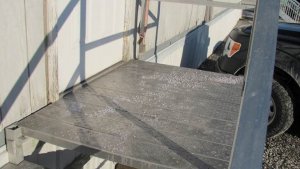The Dangers of Slips & Falls

Falls are the second-leading cause of accidental death worldwide.
In “Construction’s costliest OSHA fines of Q4 2019,” OSHA (Occupational Safety and Health Administration) states that “Falls lead the agency’s Fatal Four list, which —along with struck-by, caught-in/between, and electrocution accidents — accounted for almost 60% of construction deaths in 2018.”
- Falls – 338 out of 1,008 total deaths in construction in CY 2018 (33.5%)
- Struck by Object – 112 (11.1%)
- Electrocutions – 86 (8.5%)
- Caught-in/between* – 55 (5.5%)
(*This category includes construction workers killed when caught-in or compressed by equipment or objects, and struck, caught, or crushed in collapsing structure, equipment, or material.)
Statistics from the National Safety Council (NSC) are alarming: “It may come as a surprise that the third-leading cause of unintentional injury-related death is falling. In 2015, nearly 33,381 people died in falls at home and at work – and for working adults, depending on the industry, falls can be the leading cause of death.”
In fact, a study in the American Journal of Emergency Medicine tells us “more than 1 million Americans injure themselves on stairs each year.” The study also reveals that “the direct and indirect costs of nonfatal stair injuries total about $92 billion annually.”

A case in point: slips and falls happening to employees using outdoor aluminum steps
On November 11, 2019, a Swift & Staley Team (SST) employee slipped and fell while descending aluminum steps. At the time of the incident, there was light rain and the steps were wet. Following the incident, the steps were inspected and found to be free of damage or defect. The following day, another SST employee slipped and fell on the landing of these same steps. At the time of this second incident, the steps were wet from melted snow and ice and also had salt on them.
Upon subsequent inspection and comparison to other aluminum steps in the area, these steps were found to be of a less robust design for slip resistance than other steps in the area. The holes in the decking on these steps were smaller than the holes in the decking on other steps and protruded upward to a lesser degree. Additionally, other step landings in the area had a ribbed deck board at the leading edge of the landing whereas this landing did not.
Although the differences outlined above are subtle, the reduced slip resistance when compared to other steps SST employees are accustomed to traversing is believed to have been a factor in these incidents. The steps were flagged off to prevent use and are scheduled to be replaced with steps and a landing similar in design to other steps and landings in the area. An extent of condition was conducted, identifying another landing that SST has flagged off and scheduled for replacement.
This Lessons Learned is from OPEX, published by Swift & Staley, Paducah, KY,
Why are slips and falls so prevalent?
In a “Clearer Understanding of Slips and Falls,” OSHA states “This type of fall happens when our COG [center of gravity] is disrupted because we lose secure foot contact with the floor. . . . [this type of accident, slip and fall] tends to be the most common and thus incurs the most injuries; often we can recover our balance with the other types of slips, trips, and falls. And if we do experience a slip and fall and land on a fleshy part of the body, we often can escape serious injury. However, if we land on a bony part of the body or the fall is relatively violent in nature, the injury can be serious, even deadly.”
What questions come to mind from this incident?
Perhaps, why were the steps not flagged and the design changed after the first incident? Also, why install aluminum steps without a safety tread in the first place? Did the employers consider the Health and Safety Authority’s (HSA) “Safer Work Steps and Stairs” from its “Trips, Falls, and High-Risk Areas – Stairs and Steps” guidelines?
What questions occur to you? Have you a slip-and-fall story to share?
Did you know that workplace falls are 100 percent avoidable?
NSC sets out guidelines and tips for avoiding falls and HSA provides advice on the key hazards of steps and stairs, as well as “practical advice on four interdependent elements of safer stairs and steps.”
Founded in 1988, the TapRooT® Root Cause Analysis System solves hurdles every investigator faces
TapRooT® Root Cause Analysis Training System takes an investigator beyond his or her knowledge to think outside the box. Backed with extensive research in human performance, incident investigation, and root cause analysis, TapRooT® is a global leader in improved investigation effectiveness and productivity, stopping finger-pointing and blame, improving equipment reliability, and fixing operating problems.
System Improvements, the creator of the TapRooT® System, has a team of investigators and instructors with years of extensive training ready to offer assistance worldwide. We also offer ongoing support to our clients through free newsletters and root cause tip videos, the root cause analysis blog, and our annual Global TapRooT® Summit.
Register for a TapRooT® Course
Register for one of our TapRooT® courses. You may look through our course offerings here. For basic TapRooT® Training, we offer a 2-Day TapRooT® Root Cause Analysis Course. People who investigate low-to-medium risk incidents, precursor incidents and major incidents (serious injuries, fatalities, major facility upsets, fires and explosions, or significant environmental releases) train with the 5-Day TapRooT® Advanced Root Cause Analysis Team Leader Course. Please contact us or call us at 865.539.2139 about having a course at your site or for further root cause analysis training opportunities. We’re here to help you find solutions.



